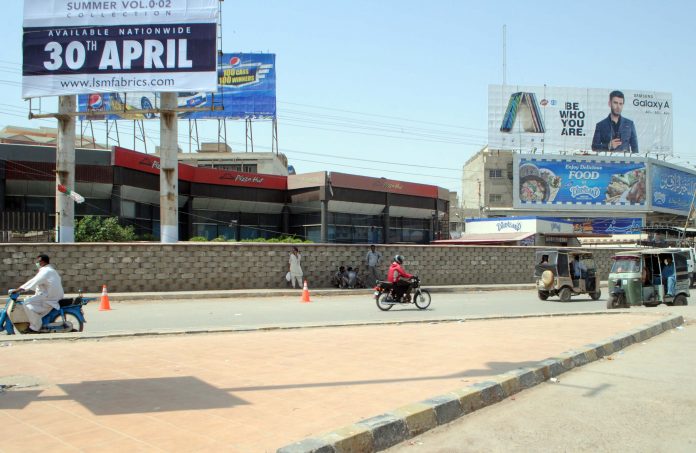Karachi
“I bet these are the best wontons you will ever have in Karachi,’’ Ali Abbas, a resident of North Nazimabad, said while munching on his freshly-fried wontons. He bought those wontons from a small shop behind Dolmen Mall in Block E, the heart of North Nazimabad, arguably the most literate and aesthetically planned area of Karachi.
‘’I have been coming here since I was a child. Initially, they only had samosas and pakoras but over time, they introduced other varieties, such as wontons and cutlets,” Abbas said of the shop, which has expanded its businesses over the past decade – and even attracts customers from the upscale neighborhoods of Defense and Clifton, about 50 kilometers down south.
‘We are happy that the area has developed so much. It brings business for us. People from Defence and Clifton also come here now, due to the presence of various malls and Hyderi market,’’ says Muffadil Saifuddin, a third generation owner of a gift shop in Barkat e Hyderi, the area’s commercial hub and the main attraction for visitors from across the city.
The businesses including the wonton and gift shops that have been operating in the vicinity for years, have benefited a great deal from the commercial development in the area. However, many big brands along with new breed of entrepreneurs have also reached out to North Nazimabad to capitalize on business opportunities offered by this emerging but lucrative market – a goldmine for retail businesses.
‘’There is more (liquidity) money in North Nazimabad and Gulshan e Iqbal, than Defence and Clifton put together,” says Shalim Reuben who is head of sales and marketing at Ego, a chain of retail outlets that deals in women wear.
Today North Nazimabad is home to various national and international brands, a strong indication that it is an emerging upscale market for businesses, especially those focused on retail.
Some of the leading brands, such as Ego, Khaadi, Junaid Jamshed (J.), QnH, Denims and Gul Ahmed have their outlets in Hyderi, Dolmen Mall. Even food lovers don’t have to look beyond this area, which has a strong presence of the world’s top food chains – the likes of Pizza Hut, McDonald’s, Burger King, Hardees, KFC, Subway and Dunkin Donuts to name a few.
North Nazimabad, which has a population of 1 million, is said to be one of the best examples of town planning in Pakistan which was initiated around late 50’s for Federal Officers. However, due to the shift of capital to Islamabad, the land was sold to general public; especially migrants from India. As time passed, commercialization took over this low inhabited area and today it is considered as a ‘Concrete Jungle’ and one of the most populated areas of Karachi.
If one takes a tour from Shershah Suri Road to Nagan Chowrangi bridge, he will find high-rise buildings on either side of the road, exchange offices, international standard shopping malls, travel agencies, wedding halls and a continuous hustle bustle of traffic – an evidence that the town once planned for the elite has slowly become home to a group that is surely bigger in size than the elite: the middle income class.
”The individual buying power of a household might be lower than a family residing in posh areas, but the collective buying power of whole North Nazimabad makes it quite an attractive market for all retail brands, even the high-end ones,” an official from QnH said.
Spread over 50 square kilometers, the area has 10 union councils and is home to a large population that is educated and well informed in their decisions thus making it a lucrative market. Not only are the major brands inclining towards the presence of a large population in this area, but also the real estate sector knows the value of the vicinity.
According to industry sources –the green bus project, dense and diverse population and availability of empty plots and bungalows are the factors that are pulling the builders towards Nazimabad. Investors are willing to invest in what they assume to be a gold mine.
The roads facing commercial and residential plots of 500-1000 square yards are currently a hot selling cake. “The average prices of these properties almost jumped four times from Rs 2.5 million to Rs12.5 million in last 10 years,’’ says a member of Association of Builders and Developers (Pakistan). He also added that builders are willing to pay any price, because they are sure to earn double profits after the construction of residential and commercial projects on these lands.
Long lost in the midst of corrupt and incompetent administration, this area of Karachi holds more than a few titles on its name. It has a first-class cricket stadium, its own mass transit railway track, well-planned water and drainage system, highest literacy rate in the city, six universities that include a medical and dental college, over 20 mosques belonging to diverse communities, separate supermarkets and parks for all blocks, numerous hospitals and schools that add value to the vicinity. While touring on 100-feet wide roads of Nazimabad; presence of larger than life billboards, the festivity in markets, glooming faces of the working class and rapidly growing economic value of the locality will tell you the main purpose for which Nazimabad was once constructed – to provide a better lifestyle to the citizens of Karachi.
Reuben of Ego, summed up the commercial significance of North Nazimabad by comparing to one of the city’s largest commercial areas:
‘’Nazimabad’s sales are equivalent to that in Tariq Road; mainly due to the density of population.’’
Additinoal reporting by Arshad Hussain
























